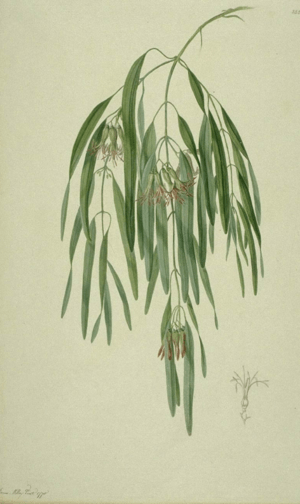Amyema biniflora facts for kids
Quick facts for kids Amyema biniflora |
|
|---|---|
 |
|
| Amyema biniflora (artist: James F. Miller (artist), 1775) | |
| Scientific classification | |
| Genus: |
Amyema
|
| Species: |
biniflora
|
 |
|
| Collections data for A. biniflora from the Australasian Virtual Herbarium | |
Amyema biniflora, also known as the twin-flower mistletoe, is a special kind of flowering plant. It's an epiphyte, which means it grows on other plants, usually trees, without touching the ground. It's also a hemiparasite, meaning it gets some of its water and nutrients from its host plant, but it can also make its own food using sunlight. This unique mistletoe is found only in Queensland, Australia, and belongs to the plant family Loranthaceae.
Contents
Discovering the Twin-Flower Mistletoe
This plant is a fascinating part of Australia's natural world. It shows how different living things can connect and depend on each other.
What Does This Mistletoe Look Like?
The twin-flower mistletoe hangs down from its host plant. Its leaves are flat and can grow up to 15 centimeters (about 6 inches) long and 1 centimeter (less than half an inch) wide.
Its flowers grow in a special way. They form an umbel, which is a cluster of flower stalks that all come from one point, like the spokes of an umbrella. These flowers usually appear in groups of two, which is why it's called the "twin-flower" mistletoe.
The flower's petals, called the corolla, are smooth and thin. They are green when the flower is fully grown. The fruit of the plant is shaped like an egg (ovoid). The small leaf-like part at the base of the flower, called a bract, does not get bigger as the fruit ripens. Both the flower buds and the fruit are smooth to the touch.
Where Does It Grow?
Amyema biniflora likes to grow on certain types of trees. You can often find it on trees known as bloodwoods and spotted gums. These are both kinds of eucalypts, which are common trees in Australia. The mistletoe attaches itself to these trees to get the water and nutrients it needs to survive.
How Was It Named?
The twin-flower mistletoe, A. biniflora, was first officially described by a scientist named Bryan Alwyn Barlow. He gave it its scientific name in 1966. Scientists give plants unique names so they can be easily identified and studied all over the world.

